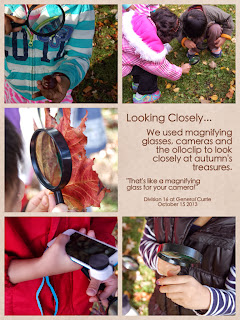When we got back to the classroom the students went through their photos and chose one that inspired them mathematically. We discussed what the photograph made them wonder about (and many of these questions had emerged when we were outside) and what kind of mathematical problem they could ask based on the photograph. During our discussion of problems we discussed how a problem really isn't a problem if you know how to solve it right away which helped students move on from the more standard word problem format (ie. There were 43 leaves on the ground and 26 blew away. How many leaves were left?).
 |
| How many pieces of garbage can fit in the garbage can? |
 |
| How many squares are in this window? |
 |
How many triangles are there? How many lines are in the wheel? Is the shape symmetrical?
|
As students posed their problems, they began to think about how they might solve them. Some students used the screencasting app ShowMe to share their photograph, state their problem and explain how they might start to figure it out.
The students emailed their photos and problems to me and during our next session together we are going to compile the photos and problems into a photo book, possibly using Book Creator on the iPads.
~Janice














































